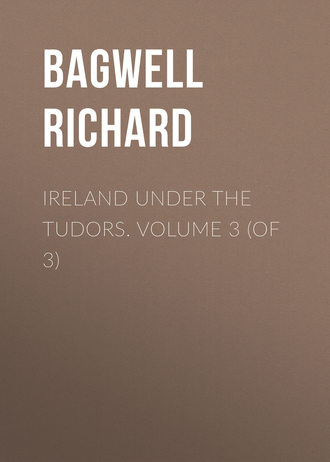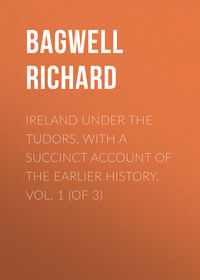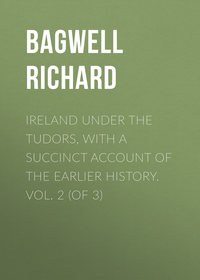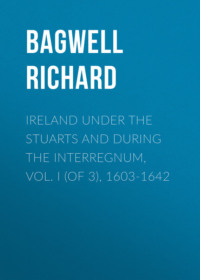 полная версия
полная версияIreland under the Tudors. Volume 3 (of 3)
355
The dates are Dublin, Sept. 14; Faughard, Sept. 20; Newry, Oct. 21. Moryson, ut sup.; Lord Deputy and Council to Carew, Oct. 8, in Carew; Mountjoy to Carew same date (No. 478); Four Masters, 1600.
356
Nov. 2-13. The Four Masters add nothing to Moryson’s account.
357
Docwra’s Narration, June 1 to July 29; Four Masters, 1600; Cecil to Carew, Sept. 28, in Maclean’s Letters of Sir R. Cecil.
358
Docwra’s Narration, July 29 to Sept. 16; Four Masters, 1600.
359
Docwra’s Narration, Sept. 16 to Oct. 3.
360
Docwra’s Narration, Oct. 3-28; Four Masters, 1600; Journal of Mountjoy’s proceedings, in Carew, vol. v. p. 497. In the Ulster settlement Docwra was granted 2,000 acres about Lifford.
361
The Four Masters are here to be preferred to Docwra; see also Cecil to Carew in Maclean, Aug. 29, 1600.
362
Docwra’s Narration, ‘about Christmas’; Four Masters, under Jan. 27, 1601.
363
Carew to the Privy Council July 18-20 and Aug. 25; Pacata Hibernia, book i. chaps. ix. – xii.
364
This fight was on Sept. 16. Pacata Hibernia, book i. chap. xiii.; Mountjoy to Carew, Oct. 8, in Carew; Cecil to Carew, Oct. 15; Carew to the Privy Council, Nov. 2.
365
Desmond to Cecil, MS. Hatfield. The letter is not dated, but Fenton was in London during July and August 1600. Writing to Carew on July 11, Cecil calls the young man James Fitzgerald, and Desmond in later letters. The patent was ready by Aug. 29, and received the Great Seal on Oct. 1. It is printed in Pacata Hibernia, book i. chap. xiv.
366
Desmond landed on Oct. 14. Nearly all the letters are collected in Florence MacCarthy’s Life, pp. 485-500, where details as to the Tower life, medicines, &c. may be read, and in Cecil’s letters to Carew (ed. Maclean).
367
Pacata Hibernia, vol. i. ch. xiv. and the letters in Florence MacCarthy’s Life; Carew to Cecil in Carew, March 22, 1601. ‘I do not at all, or at least very little,’ Desmond wrote to Cecil on Dec. 18, 1600, ‘participate of the Italian proverb, Amor fa molto, argento fa tutto.’
368
Fenton to Cecil, April 20, 1598. William Power, writing from Cork to Cecil, Jan. 17, 1602, says ‘you were a father to the unfortunate young Earl, as himself often told me.’ – Carew to the Privy Council, Dec. 20, 1600, and March 6, 1601; Pacata Hibernia, book i. chap. xviii.; Desmond Pedigree in Irish Arch. Journal, 3rd series, vol. i.; Desmond to Cecil, Aug. 31, 1601. Among the 1602 papers at Hatfield, there are petitions from two of the Desmond ladies asking Cecil for part of the allowance meant ‘for our poor brother, that we might end the rest of our unfortunate days without being troublesome.’
369
The Queen to Mountjoy, Dec. 3, 1600, copy in Carew. There are other letters of the time from Elizabeth to the Lord Deputy beginning ‘Mistress kitchenmaid.’
370
Moryson, part ii. book i. chap. ii. On Jan. 1, 1601, Mountjoy dates a letter to Carew (in Carew) ‘from the camp among the rocks and the woods in these devils’ country.’
371
Moryson, Jan. 29 to Feb. 25, part ii. book ii. chap. ii.; Mountjoy to Carew, March 11, in Carew.
372
Essex was arrested Feb. 8 and executed Feb. 25. Mountjoy heard the news on the 22nd and March 2 respectively. Moryson, book i. ch. ii.
373
Nottingham to Mountjoy, May 31, 1601, enclosing Lady Rich’s letter. Notwithstanding the Lord Admiral’s playful allusion to 30 years, Mountjoy was 38 and Penelope 40. The letters are printed in Goodman’s James I. ii. 14-20.
374
Moryson ut sup.; Mountjoy to Carew, April 10, 1601, in Carew; Edmund MacGauran, titular Archbishop of Armagh, to Captain Eustace June 18/28, 1591, MS. Hatfield; Matthew de Oviedo, ‘Spanish Archbishop of Dublin,’ to James Fitzthomas, Jan. 3/13, 1601-2, in Pacata Hibernia, book i. chap. xix.
375
Pacata Hibernia, book ii. chap. iii. White Knight to Carew, May 29, 1601. Many of the letters &c. on this subject are collected in Irish Arch. Journal, 3rd series, vol. i. pp. 544-559. O’Daly wrongly states that the Queen’s Earl stayed on in Ireland after his rival: he returned to England two months before his capture. From State papers calendared under June and July, 1608, it appears that John Fitzthomas was then called Earl of Desmond in Spain.
376
May 22 to Aug. 29, 1601; Moryson, part ii. book ii. chap. i.
377
Information of Thomas Walker (taken in England), Oct. 3, 1601, MS. Hatfield; Walker to Mountjoy, Aug. 22; Mountjoy to Cecil, Aug. 23. Walker maintained that he never thought of killing Tyrone until he found himself in Ireland.
378
The proclamation is in Morrin’s Patent Rolls, 1601, of which several original printed copies are extant, bearing date May 20, 1601. The whole story may be read in Carew, 1601-3, and in the first vol. of Russell and Prendergast’s Calendar. See also Camden and Moryson. In Feb. 1603 Mountjoy wrote: ‘the alteration of the coin, and taking away of the exchange, in such measure as it was first promised, hath bred a general grievance unto men of all qualities, and so many incommodities to all sorts, that it is beyond the judgment of any that I can hear to prevent a confusion in this estate by the continuance thereof.’
Moryson says the pretence was that the rebels would be impoverished, whereas the Queen’s servants were the real sufferers – ‘we served in discomfort and came home beggars, so that only the treasurers and paymasters had cause to bless the authors of this invention.’
379
Carew to the Privy Council, Aug. 6, 1601; Cecil to Carew, Sept. 5 – both in Carew. ‘For Desmond (James Fitzthomas),’ says Cecil, ‘I find him more discreet than I have heard of him, and for Florence the same which I ever expected, which is a malicious, vain fool.’ —Pacata Hibernia, lib. ii. cap. 6.
380
Journal in Carew, No. 198; Pacata Hibernia, cap. 10; Carew to the Privy Council, Sept. 14.
381
Pacata Hibernia, caps. 9, 10, and 11. The Spanish ships are described as fifty, forty-five, and thirty-five. The latter number probably came to Kinsale with Don Juan. Storms and accidents account for the rest. Small vessels had been purposely chosen, with a view to the Irish harbours.
382
Pacata Hibernia, caps. 10 and 11; Warrants in Carew, Sept. 28.
383
Pacata Hibernia, cap. 13; Fynes Moryson, part ii. book ii. chap. ii.; Journal in Carew (No. 199) Oct. 29 to Nov. 1.
384
Journal in Carew, Nos. 199 and 200; Four Masters, 1601; Docwra’s Narration, p. 257. Castle Park fell on Nov. 20.
385
Four Masters, 1601; Pacata Hibernia, cap. 14; Journal in Carew, No. 200; Carew to Mountjoy, Nov. 22. Carew returned to the camp on Nov. 26.
386
Journal in Carew (No. 200) Nov. 29 to Dec. 9 Pacata Hibernia caps. 17, 18, and 19; Cecil to Carew, Feb. 9, 1602.
387
Journal in Carew (Nos. 200 and 201) Dec. 7-20; Letters of Don Juan d’Aguila, Dec. 10/28, in Pacata Hibernia; Fenton to the Queen, Dec. 4, printed in the Ulster Journal of Archæology, vi. p. 64.
388
Pacata Hibernia, caps. 15 and 18; Four Masters, 1601.
389
Journal in Carew (No. 201) Dec. 21-3; Pacata Hibernia, cap. 21; Moryson. The Four Masters and O’Sullivan both say the English were on their guard, and the former note the report of treachery, but without giving MacMahon’s name.
390
Mountjoy’s report is in Carew (No. 201). His private secretary, Fynes Moryson, the historian, was present. Carew’s account is in Pacata Hibernia. The Four Masters and O’Sullivan Bere are to be preferred for the movements of the Irish, and the latter may have learned some particulars from his uncle. See also Sir H. Power (who commanded the flying column) to Cecil, Dec. 27.
391
Four Masters, 1602; Lord Deputy and Council to the Privy Council, Jan. 14; Carew to same, Jan.; Sir F. Stafford to Cecil (from Newry) Jan. 14; Clanricarde to Cecil (from Cork) Jan. 15. ‘The rebels are utterly forsaken of all aid from the Spaniards, and not able to make any head. O’Donnell is made away for Spain, as we think. I do not think we have lost fewer than 3,000 men; by fights and hurts not above 300, all the rest by sickness.’ Captain A. Enfield, R.N., to Fulke Greville, Jan. 6, in 12th Report of Historical MSS. Commission —Coke MSS.
392
A short relation of the siege of Kinsale in Carew (No. 202) signed by Mountjoy, Carew, and others. O’Sullivan and others say the English outnumbered Tyrone’s forces. It is true that the Irish made no general or united effort, but only a small section of Mountjoy’s army was actually engaged. Moryson, who was present, says the former were 6,000 foot and 500 horse, the latter barely 1,200 and 400.
393
Translations of the letters from the Duke of Lerma and others are in Pacata Hibernia, ii. chap. xxvi., the terms of capitulation (Jan. 2, 1602) in chap. xxiii. See Carew to the Privy Council, Jan.
394
Letters to the King of Spain and the Governor of Galicia in Pacata Hibernia, ii. chap. xxviii.
395
Pacata Hibernia, ii. chap. xxix. and iii. chap. xiii. Don Pedro de Heredia to Lord Carew, April 1, 1618, and the answer, Oct. 21, both in Carew. Don Juan’s peaceful proposals are mentioned by Moryson.
396
The Queen to Mountjoy, Jan. 12, in Moryson; the Earl of Cork’s True Remembrances.
397
The Queen to Mountjoy, Feb. 8 1601; Cecil to Mountjoy, received July 8, both in Moryson.
398
Cecil to Mountjoy, Aug. 7 in Moryson; to Carew of Feb. 9, 1602, and throughout that year in Maclean; Chamberlain’s Letters, June 27, 1602.
399
Moryson, May 30 to July 19, on which day Mountjoy reached Monaghan; Chichester to Cecil, June 20 and 2_
400
Mountjoy to Cecil, June 5, 1602, and Jan. 8, 1603; Cecil to Windebank, June 15, 1602. Windebank read the latter to the Queen.
401
Journal among R.O. MSS. Ireland, April 23 to May 7; Pacata Hibernia, book ii. chaps. ii. and iii.
402
Pacata Hibernia, book iii. chaps. iii. and iv.
403
Journal, May 13 to June 1; Carew to Cecil, Aug. 6, 1601, May 29, 1602; Pacata Hibernia, book iii. chap. v.; Carew to Mountjoy, June 1 1602, in Carew.
404
Journal June 1-17; Carew to the Privy Council, Jan. 22, 1603; Pacata Hibernia, book iii. chaps. vi. vii. and viii.
405
Journal, June 12.
406
Journal, June 17-18.
407
Examination of Dominic Collins, July 9, 1602; Pacata Hibernia book iii. chap. ix.; Four Masters, 1602. There is a life of O’Colan in Hibernia Ignatiana, pp. 89-102.
408
Four Masters, 1602; O’Donnell to O’Connor Kerry, May 24, in Carew; List of Irish refugees in Pacata Hibernia, book ii. chap. xxii. The extreme claim of the O’Donnells included not only Tyrconnell, but Tyrone, Fermanagh, and all Connaught; see Docwra’s Narration.
409
For James Blake’s designs see Carew to Mountjoy, May 28 and Oct. 9, in Carew and Pacata Hibernia, book iii. chap. xv. The story of John Anias may be read in the Life of Florence MacCarthy, Maclean’s Letters of Cecil to Carew, and in Pacata Hibernia, book iii. chap. vii. For Tyrconnell’s case see Wotton to James I., April 24, 1608, in Russell and Prendergast’s Calendar, and his subsequent letters in the same volume.
410
Lambert to Mountjoy, June 18, 1602; Four Masters.
411
Docwra’s Narration, 1602 till April 20. Docwra to the Privy Council, March 11.
412
Docwra’s Narration, June to September; Tyrone to O’Connor Sligo in Moryson, book iii. chap. ii.; Mountjoy to Lambert, Sept. 12; Lord Dunkellin and Sir A. Savage to Mountjoy, Aug. 7; Mountjoy to Cecil, Oct. 12.
413
Pacata Hibernia, book iii. chaps. xii. and xiv.; Cecil to Carew, Oct. and Nov. 4; Privy Council to Carew, Dec. 16 – all in Carew.
414
O’Sullivan Bere, Hist. Cath. tom. iii. lib. vii. chaps. viii. to xii. The Four Masters describe this wonderful march to Aughrim, and are perhaps preferable as far as they go. See also Pacata Hibernia, book iii. chap. xvii. The itinerary is as follows, as near as I can make it out: – 1. (Jan. 4) Ballyvourney; 2. Pobble O’Keefe (near Millstreet); 3. Ardpatrick (in Limerick); 4. Solloghead (near Limerick Junction); 5 and 6. Ballinakill (in Tipperary); 7. Latteragh (eight miles south of Nenagh); 8. Loughkeen; 9 and 10. Portland; 11. Aughrim (in Galway); 12. Ballinlough (in Roscommon); 13 and 14. Woods near Boyle; 15. Knockvicar; 16. Leitrim. The dates are made clear by Carew’s letter to the Privy Council, Jan. 22, 1603, in Carew.
415
Tyrone to Mountjoy, Dec. 12/22, 1602, and March 19/29, 1603; Moryson, book iii. chap. i.; Pacata Hibernia, book iii. chap. xx.; Carew to the Privy Council, Jan. 22, in Carew, and Cecil’s letter to Carew, passim; O’Connor Sligo to Cecil, March 1, 1603.
416
Docwra’s Narration, December; Bodley’s visit to Lecale in vol. ii. of Ulster Arch. Journal; Capt. Thomas Phillips to Cecil, July 27, 1602; Mayor and Sheriffs of Dublin to Cecil, Jan. 17, 1603; Mountjoy to Cecil, Jan. 8 and 20; Docwra to the Privy Council, Feb. 23.
417
Moryson, part iii. book iii. chaps. i. and v.; O’Sullivan, tom. iii. lib. viii. cap. 6; Four Masters, 1603. In describing his visit to Lecale at the beginning of 1603, Bodley casually remarks that the Irish soldiers ate grass —vescuntur gramine. Moryson says the wild Irish ‘willingly eat the herb shamrock, being of a sharp taste, which as they run and are chased to and fro, they snatch like beasts out of the ditches.’ This passage is conclusive proof that the wood-sorrel was called shamrock in the sixteenth century; see above, note to chap. xxxix. Modern claimants to the title of shamrock are the white clover, the common trefoil (medicago lupulina), and the bog-bean (menyanthes trifoliata); but none of these are edible by men.
418
Queen Elizabeth to King James VI., June or July, 1585, in Bruce’s Letters of those two sovereigns, also Dec. 2, Feb. 3, 1601-2, and ‘after July,’ 1602; James VI. to Tyrone, Aug. 10, 1597, in Lansdowne MSS.; Tyrone to James VI., April 10, 1600, in Scotch Calendar; and the letters printed in Ulster Arch. Journal, vol. v. pp. 205-8.
419
Mountjoy to Cecil, Jan. 20, 1603; to Vice-Treasurer Carey, Jan. 25; Lord Deputy and Council to the Privy Council, Feb. 26 (draft in Carew).
420
Cecil to Mountjoy, Feb. 18, 1603, in Carew; Moryson, book iii. chap. ii.
421
Moryson, book iii. chap. ii.
422
There is a valuable paper on hawks and hounds in Ireland by Mr. J. P. Prendergast in vol. ii. of the Irish Arch. Journal, p. 144. Perrott to Walsingham, Oct. 25, 1585; Sir S. Bagenal to Cecil, MS. Hatfield, Nov. 1, 1602. In the second edition (1888) of Dalziel’s British Dogs there is a very full dissertation on the Irish wolf-hound. In Payne’s Brief Description of Ireland, 1590, we read that a red-deer skinned could be had for 2s. 6d., twelve quails for 3d., twelve woodcocks for 4d., and all other fowl rateably. The abundance of corncrakes is mentioned by both Moryson and Payne, and the latter says grouse (heathcock) were plentiful. Sixteen landrails (or corncrakes) were shot at Colebrooke in Fermanagh on one September day in 1884.
423
Fynes Moryson’s Itinerary, part iii. book iii. chap. v. Sir N. White to Burghley, July 22, 1580. For ploughing by the tail, &c. see Dineley’s Tour, p. 162. The Scotch Highlanders bled their cattle even to the 19th century, see the Duke of Argyle’s Scotland as it was and as it is, vol. ii. p. 123. Cæsar says of the Britons: ‘pecorum magnus numerus… Interiores plerique frumenta non serunt, sed lacte et carne vivunt.’ (B.G. lib. v. cap. 12-14.) Payne says a fat sheep could be had in 1590 for 2s. 6d. and a fat beef for 13s. 4d. ‘Filthy butter,’ says Moryson; ‘hairy butter too loathsome to describe,’ says Andrew Trollope.
424
Several notices are collected in Ulster Journal of Archæology, iii. 186, 187. See Grose’s Antiquarian Repository, iv. 627. The lax-weir at Limerick preserves the Norse name for salmon.
425
Moryson, III. iii. 5; Dymmok’s Treatise of Ireland, about 1600; Petty’s Political Anatomy, 1672; Sir T. Heneage to Carew, Dec. 22, 1590, in Carew. On July 19, 1602, the mayor of Waterford sent Cecil ‘a pair of bed coverings and two rendells of aqua-vitæ.’ – MS. Hatfield.
426
Irish Statutes, 3 and 4 Ph. and Mary, cap. 7; Moryson, III. iii. 5; Dymmok; Bodley’s Descriptio itineris in Lecaliam, ann. 1602; Barnaby Riche’s Treatise delivered to Lord Salisbury 1610. After the journey described further on, Captain Bodley and his friends warmed themselves with sherry ‘with burnt sugar, nutmeg, and ginger.’
427
Dymmok and Moryson, ut sup.; Andrew Trollope to Walsingham (from Dublin), Sept. 12, 1581. Trollope had then been over two months in Ireland. There are some curious details in the Travels of Nicander Nucius, a Corfiote, who visited England in Henry VIII.’s time, printed (Greek text and translation) by the Camden Society.
428
Fenton to Burghley, Aug. 26, 1595; Mayor of Chester’s letter, June 18, 1597; Sir John Dowdall to Burghley, March 9, 1596, and to Cecil, Jan. 2, 1600; Proclamation by Tyrone, Feb. 2, 1601. The Irish text of the latter, with a contemporary translation, is printed from the Lambeth MSS. in Ulster Arch. Journal, vol. vi. p. 60. Mountjoy to Cecil, Aug. 10, 1602, printed by Moryson.
429
Fynes Moryson’s Itinerary, part iii. book iv. chap. ii.; Spenser’s State of Ireland; Derrick’s Image of Ireland, where the description of the more uncivilised natives closely resembles those of Moryson and Spenser. Articles with Tyrone, June 17, 1590, in Carew. A paper dated 1599 by Carew (No. 319) proposes that every soldier should have an Irish mantle, ‘which costeth but 5s., to be his bed in the night and a great comfort to him in sickness and health; for being never so wet, it will with a little shaking and wringing be presently dry.’ Among the properties for a play on the state of Ireland by John Heywood, performed before Edward VI. were ‘three yards of grey kersey for an Irishman’s coat with great and long plyghts, four yards of orange-coloured frisado at 4s. a yard, &c.’ – Kempe’s Loseley MSS.
430
Von Raumer’s Sixteenth Century, letter 60, where De Beaumont, or his translator, writes Clancarty instead of Clanricarde; Manningham’s Diary, Oct. 1602 and April 1603; Chamberlain’s Letters, Oct. 2, 1602; Sir John Davis to Cecil, Dec. 8, 1604.
431
Spenser; Campion; Bodley’s Voyage to Lecale in the 2nd vol. of the Ulster Arch. Journal, and articles by H. F. Hore in the same journal; Morrin’s Patent Rolls, 40 Eliz. No. 54; Derrick’s Image of Ireland; Smith’s Cork, i. 249; and see above vol. ii. p. 65. The ‘carrows’ were not extinct in Charles II.’s time – see Dineley’s Tour, p. 19.
432
Bodley’s Visit to Lecale, 1603; Cecil to Carew. Dec. 15, 1600; Sir John Stanhope to Carew, Jan. 26, 1601: both in Carew.
433
‘Descriptio Itineris Capitanei Josiæ Bodlei in Lecaliam, 1602-3,’ Ulster Arch. Journal, ii. 73.
434
The identification of Elizabeth Boyle is due to Mr. Grosart. Bryskett’s description of the party at his house has been reprinted by several of Spenser’s biographers. For topographical matters see a most thorough article by Dr. P. W. Joyce in Fraser’s Magazine for March 1878, p. 315. Dr. Joyce hesitates to identify ‘the stony Aubrion,’ but is it not the Burren in Carlow?
435
Cotton’s Fasti; Brady’s Episcopal Succession.
436
Considerations touching Munster, 1587, No. 70; Andrew Trollope to Walsingham, Oct. 26, 1587. Sir William Russell is said to have advised liberal grants of church lands to the nobility of both persuasions, ‘who would then hold their religion with their lands, in capite.’
437
Spenser’s View of the State of Ireland, 1596. Some of the poet’s words might suggest Swift’s savage outburst about the worthy divines appointed to Irish sees who were uniformly robbed and murdered on Hounslow Heath ‘by the highwaymen frequenting that common, who seize upon their robes and patents, come over to Ireland, and are consecrated bishops in their stead.’
438
Cornelius, bishop of Killaloe, to O’Rourke, Feb. 13, 1596; Sir John Dowdall to Cecil, March 9, 1596; Memorial among the Rawlinson MSS. July 28, 1592, printed in Irish Arch. Journal, i. 80; Dominic O’Colan’s confession, July 9, 1602.
439
Pelham to Walsingham, Dec. 7, 1579; Bishop Middleton to Walsingham, June 29, July 21, and Aug. 19, 1580. ‘They call their city young Rochelle; I pray God it be not ironice dictum.’ And see John Shearman, schoolmaster of Waterford, to Primate Long, July 12, 1585.
440




